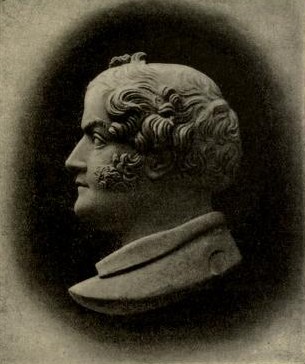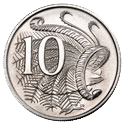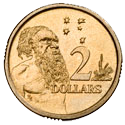
The sovereign is a British gold coin with a nominal value of one pound sterling (£1) and contains 0.2354 troy oz of pure gold. Struck since 1817, it was originally a circulating coin that was accepted in Britain and elsewhere in the world; it is now a bullion coin and is sometimes mounted in jewellery. In addition, circulation strikes and proof examples are often collected for their numismatic value. In most recent years, it has borne the design of Saint George and the Dragon on the reverse; the initials of the designer, Benedetto Pistrucci, are visible to the right of the date.

Benedetto Pistrucci was an Italian gem-engraver, medallist and coin engraver, probably best known for his Saint George and the Dragon design for the British sovereign coin. Pistrucci was commissioned by the British government to create the large Waterloo Medal, a project which took him thirty years to complete.

A mint is an industrial facility which manufactures coins that can be used as currency.

The Royal Australian Mint is the sole producer of all of Australia's circulating coins and is a Commonwealth Government entity operating within the portfolio of the Treasury. The Mint is situated in the Australian federal capital city of Canberra, in Denison St, in the suburb of Deakin. The Mint was opened in 1965 by Prince Philip, Duke of Edinburgh.
Thomas Wyon the Younger was an English medallist and chief engraver at the Royal Mint.

Christian Gobrecht was the third Chief Engraver of the United States Mint from 1840 until his death in 1844. He was responsible for designing the famous "Seated Liberty" designs, which were in turn the direct inspiration for the design of the Trade Dollar. He designed the Gobrecht Dollar, which was struck in small quantities from 1836 to 1838 and later inspired the Flying Eagle cent. He also designed the obverse sides for the Liberty head Quarter Eagle, Half Eagle, and Eagle gold coins, as well as the "braided hair" type Half cent and Large cent coins.

A medalist is an artist who designs medals, plaquettes, badges, metal medallions, coins and similar small works in relief in metal. Historically, medalists were typically also involved in producing their designs, and were usually either sculptors or goldsmiths by background. In modern times, medalists are mostly primarily sculptors of larger works, but in the past the number of medals and coins produced were sufficient to support specialists who spent most of their career producing them. From the 19th century, the education of a medalist often began with time as an engraver, or a formal education in an academy, particularly modeling and portraiture. On coins, a mark or symbol signifying the medalist as the original designer was often included in a hidden location and is not to be mistaken for the symbol of the mint master. Artistic medals and plaquettes are often signed prominently by the artist.
Frank Gasparro was the tenth Chief Engraver of the United States Mint, holding this position from February 23, 1965, to January 16, 1981. Before that, he was Assistant Engraver. He designed both sides of the Susan B. Anthony dollar, both sides of the Eisenhower Dollar, the Lincoln Memorial reverse of the cent, and the reverse of the Kennedy half dollar.

The Australian ten-cent coin is a coin of the decimal Australian dollar. When the dollar was introduced as half of an Australian pound on 14 February 1966, the coin inherited the specifications of the pre-decimal shilling; both coins were worth one twentieth of a pound and were called "bob". On introduction it was the fourth-lowest denomination coin. Since the withdrawal from circulation of the one and two cent coins in 1992, it has been the second-lowest denomination coin in circulation.

The Australian two-dollar coin is the highest-denomination coin of the Australian dollar. It was first issued on 20 June 1988, having been in planning since the mid-1970s. It replaced the Australian two-dollar note due to having a longer circulatory life. The only "mint set only" year was 1991.
Barbara Gillian Briggs is one of the foremost Australian botanists. The IK lists 205 names of plants which have been published or co-published by her. She was one of the botanists in the Angiosperm Phylogeny Group, of the 1998Archived 22 August 2006 at the Wayback Machine APG system.
Nicholas Briot was an English coin engraver, medallist and mechanical engineer. Born in France, he emigrated to England and became chief engraver to the Royal Mint in 1633 and is credited with the invention of the coining-press.
Thomas Shingles was the Master Engraver of the Royal Canadian Mint from 1943 until his retirement in 1965; he first began work at the Mint in 1939. He was born in Birmingham, England.

Leonard Charles Wyon was a British engraver of the Victorian era most notable for his work on the gold and silver coinage struck for the Golden Jubilee of Queen Victoria in 1887 and the bronze coinage of 1860 with the second ("bun") head portrait, in use from 1860 to 1894.

James Barton Longacre was an American portraitist and engraver, and the fourth chief engraver of the United States Mint from 1844 until his death. Longacre is best known for designing the Indian Head cent, which entered commerce in 1859, and for the designs of the Shield nickel, Flying Eagle cent and other coins of the mid-19th century.
Wojciech Pietranik is a Polish artist and sculptor best known for his design work for coins and medals.

John Croker, born in Saxony and known in his youth as Johann Crocker, was a master jeweller who migrated to London, where he became a medallist and engraved dies for English and later British coins and medals.
William Henry James Blakemore was an English engraver, and medallist at the Royal Mint London. Signature: WHJB

Jean-Pierre Droz was a coin and medal engraver born in Switzerland and trained in Paris. Droz was most known for engraving the Napoléon coin at the Paris Mint.
Jacob Abraham (Abram) (1723, Strelitz – June 17, 1800, Berlin) was a German Jewish medalist and lapidary.











